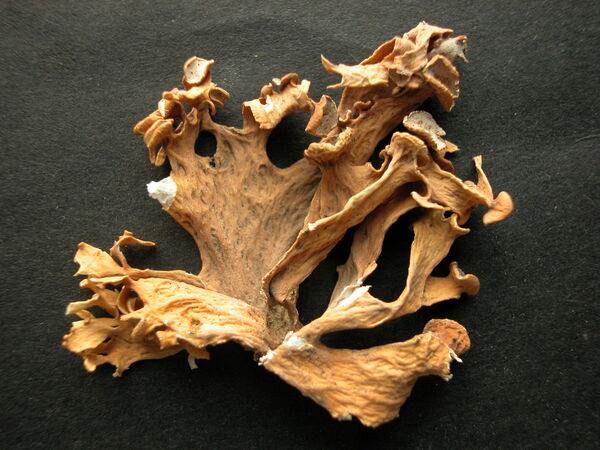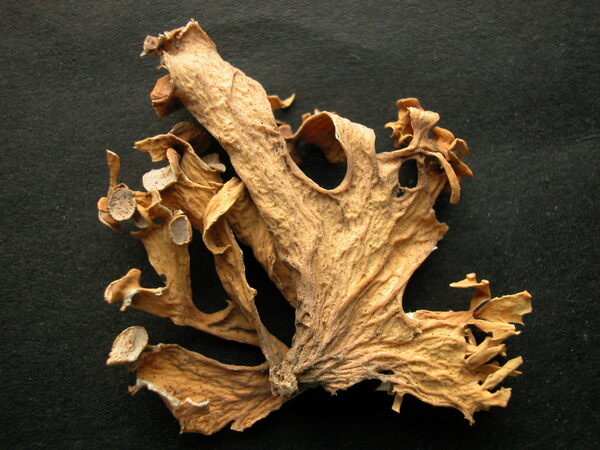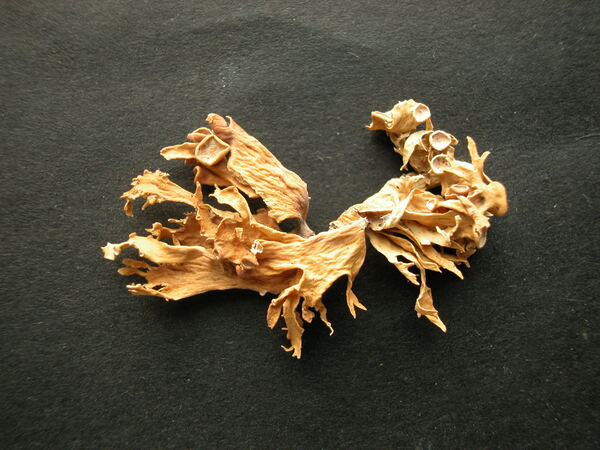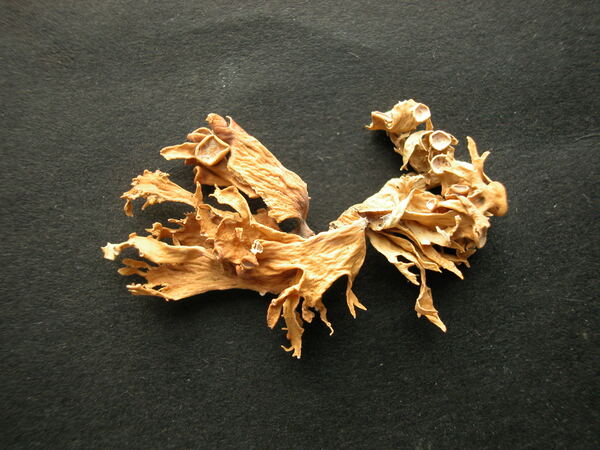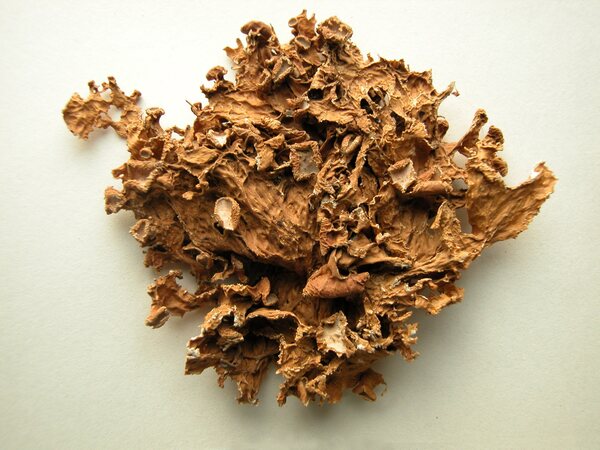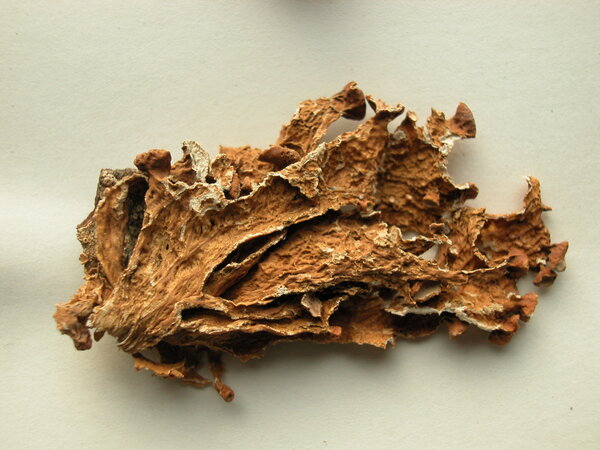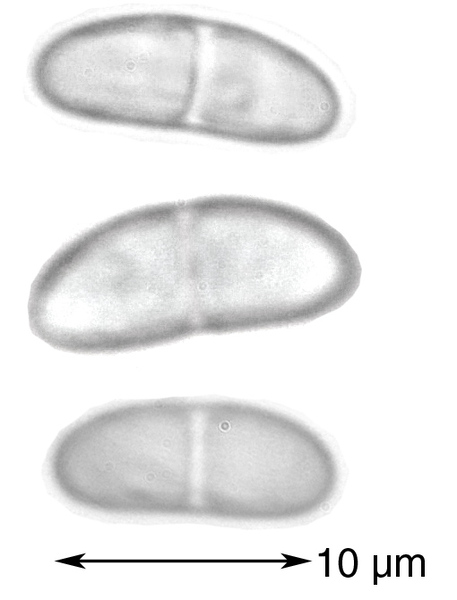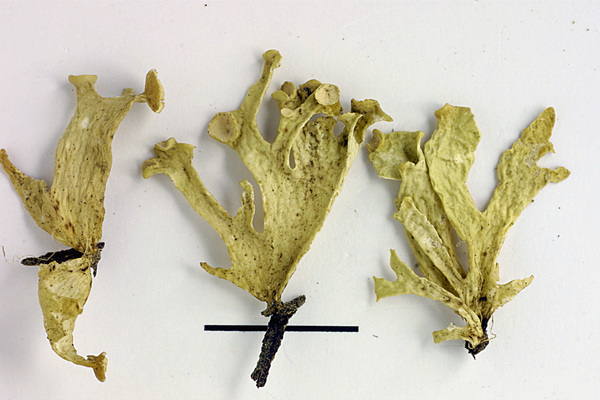Ramalina lusitanica H. Magn.
Bot. Not., 109: 149, 1956.
Synonyms:
Distribution: C - Laz, Sar (Zedda 2002, 2002b, Spjut & al. 2020, Lich. Ital. Exs. 62: Isocrono & al. 2022). S - Camp.
Description: Thallus fruticose, yellowish green to straw-coloured, slightly dorsiventral (one face often somehow paler and more rugose than the other), usually monophyllous, consisting of simple to sparingly branched, 1-3(-4) cm long, up to 5(-10) mm wide, rather thin and papery but usually stiff, smooth to furrowed, rarely weakly reticulately ridged, often fan-shaped laciniae; pseudocyphellae absent. Cortex thin, underlain by chondroid strands; medulla white, compact. Apothecia common, lecanorine, 2-4(-5) mm across, terminal or marginal, sometimes also laminal, with a greenish disc and a usually rugose thalline margin, sometimes short-spurred. Epithecium pale brownish-olive; hymenium and hypothecium colourless; paraphyses thick-walled, richly branched in upper part. Asci 8-spored, the apical dome K/I+ dark blue with a pale, conical-pointed apical cushion (axial mass), the wall I-, but the thin outer gel I+ blue, Bacidia-type. Ascospores 1-septate, hyaline, ellipsoid, straight to slightly curved, (10-)11-13(-14) x (3-)4-5.5 μm. Photobiont chlorococcoid. Spot tests: K-, C-, KC- (or cortex KC+ faintly yellow), P-, UV+ white or UV-. Chemistry: cortex with usnic acid: medulla with variable amounts of divaricatic acid and an unknown fatty acid.Note: a typically Mediterranean species of coastal maquis vegetation subject to humid maritime winds, found on twigs of evergreen shrubs and small trees in open situations. It is included in the Italian red list of epiphytic lichens as “Vulnerable” (Nascimbene & al. 2013c).
Growth form: Fruticose
Substrata: bark
Photobiont: green algae other than Trentepohlia
Reproductive strategy: mainly sexual
Most common in areas with a humid-warm climate (e.g. most of Tyrrenian Italy)
Commonnes-rarity: (info)
Alpine belt: absent
Subalpine belt: absent
Oromediterranean belt: absent
Montane belt: absent
Submediterranean belt: absent
Padanian area: absent
Humid submediterranean belt: absent
Humid mediterranean belt: extremely rare
Dry mediterranean belt: absent
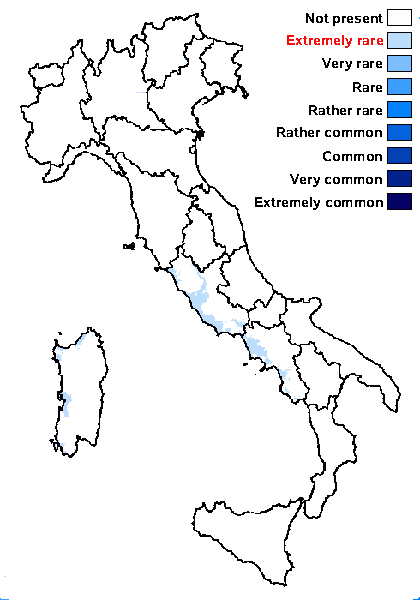
Predictive model
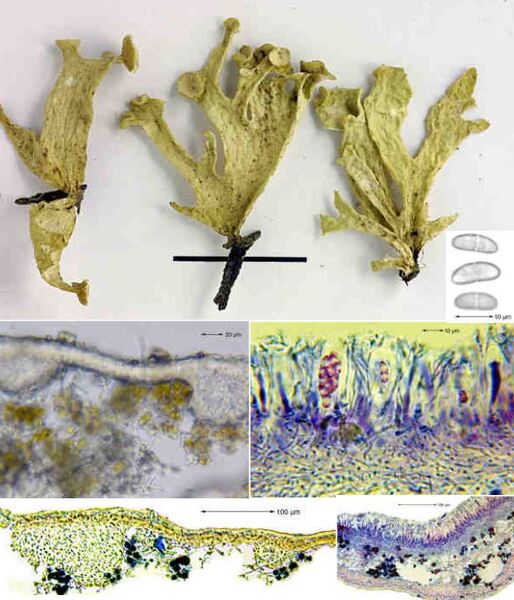

Felix Schumm – CC BY-SA 4.0
Image from: F. Schumm (2008) - Flechten Madeiras, der Kanaren und Azoren. Beck, OHG - ISBN: 978-3-00-023700-3
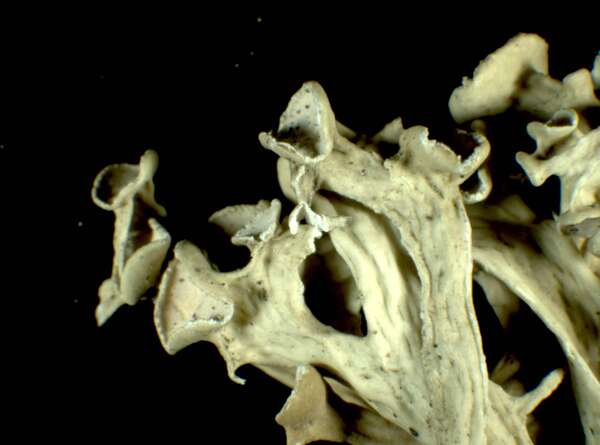

P.L. Nimis; Owner: Department of Life Sciences, University of Trieste
Herbarium: TSB (20845)
2001/12/04

Felix Schumm - CC BY-SA 4.0
[10611], Portugal, Azoren, Sao Miguel: Agua de Pau, an Erica-Zweigen an der Atlantikküste bei der Hotelanlage Caloura, hohe Luftfeuchtigkeit und Salzeinfluß, 37°42.847'N, 25°30.906'W, 10-20 m. Leg. F. Schumm , 01.06.2003, det. F. Schumm 04.2006, conf. A. Aptroot 2007.

Felix Schumm - CC BY-SA 4.0
[10611], Portugal, Azoren, Sao Miguel: Agua de Pau, an Erica-Zweigen an der Atlantikküste bei der Hotelanlage Caloura, hohe Luftfeuchtigkeit und Salzeinfluß, 37°42.847'N, 25°30.906'W, 10-20 m. Leg. F. Schumm , 01.06.2003, det. F. Schumm 04.2006, conf. A. Aptroot 2007.
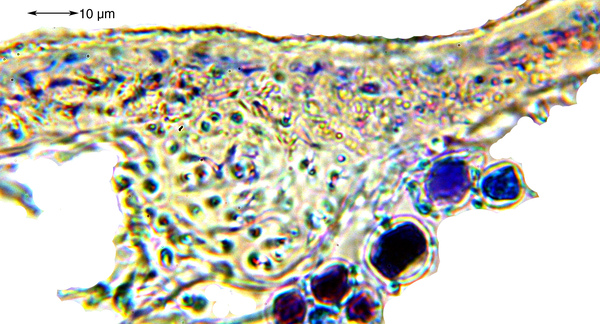
Felix Schumm - CC BY-SA 4.0
[10611], Portugal, Azoren, Sao Miguel: Agua de Pau, an Erica-Zweigen an der Atlantikküste bei der Hotelanlage Caloura, hohe Luftfeuchtigkeit und Salzeinfluß, 37°42.847'N, 25°30.906'W, 10-20 m. Leg. F. Schumm , 01.06.2003, det. F. Schumm 04.2006, conf. A. Aptroot 2007.

Felix Schumm - CC BY-SA 4.0
[10611], Portugal, Azoren, Sao Miguel: Agua de Pau, an Erica-Zweigen an der Atlantikküste bei der Hotelanlage Caloura, hohe Luftfeuchtigkeit und Salzeinfluß, 37°42.847'N, 25°30.906'W, 10-20 m. Leg. F. Schumm , 01.06.2003, det. F. Schumm 04.2006, conf. A. Aptroot 2007.
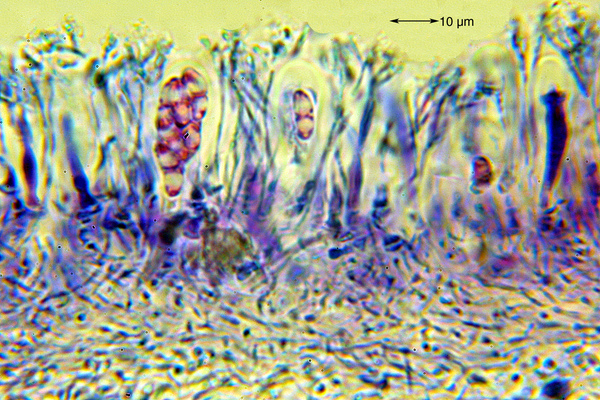
Felix Schumm - CC BY-SA 4.0
[10611], Portugal, Azoren, Sao Miguel: Agua de Pau, an Erica-Zweigen an der Atlantikküste bei der Hotelanlage Caloura, hohe Luftfeuchtigkeit und Salzeinfluß, 37°42.847'N, 25°30.906'W, 10-20 m. Leg. F. Schumm , 01.06.2003, det. F. Schumm 04.2006, conf. A. Aptroot 2007.
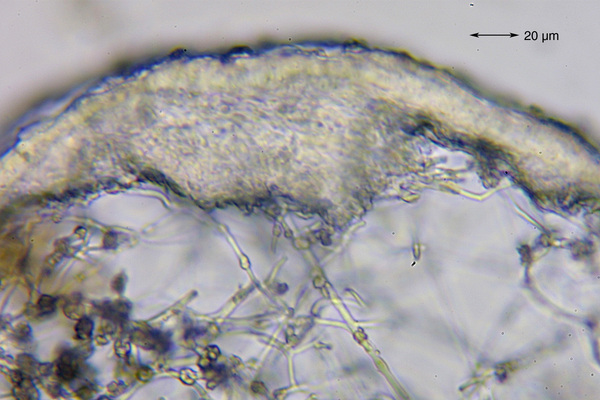
Felix Schumm - CC BY-SA 4.0
[10611], Portugal, Azoren, Sao Miguel: Agua de Pau, an Erica-Zweigen an der Atlantikküste bei der Hotelanlage Caloura, hohe Luftfeuchtigkeit und Salzeinfluß, 37°42.847'N, 25°30.906'W, 10-20 m. Leg. F. Schumm , 01.06.2003, det. F. Schumm 04.2006, conf. A. Aptroot 2007.
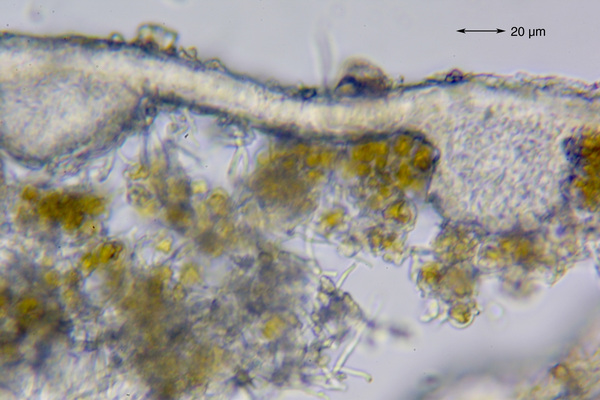
Felix Schumm - CC BY-SA 4.0
[10611], Portugal, Azoren, Sao Miguel: Agua de Pau, an Erica-Zweigen an der Atlantikküste bei der Hotelanlage Caloura, hohe Luftfeuchtigkeit und Salzeinfluß, 37°42.847'N, 25°30.906'W, 10-20 m. Leg. F. Schumm , 01.06.2003, det. F. Schumm 04.2006, conf. A. Aptroot 2007.

Felix Schumm - CC BY-SA 4.0
[10611], Portugal, Azoren, Sao Miguel: Agua de Pau, an Erica-Zweigen an der Atlantikküste bei der Hotelanlage Caloura, hohe Luftfeuchtigkeit und Salzeinfluß, 37°42.847'N, 25°30.906'W, 10-20 m. Leg. F. Schumm , 01.06.2003, det. F. Schumm 04.2006, conf. A. Aptroot 2007.
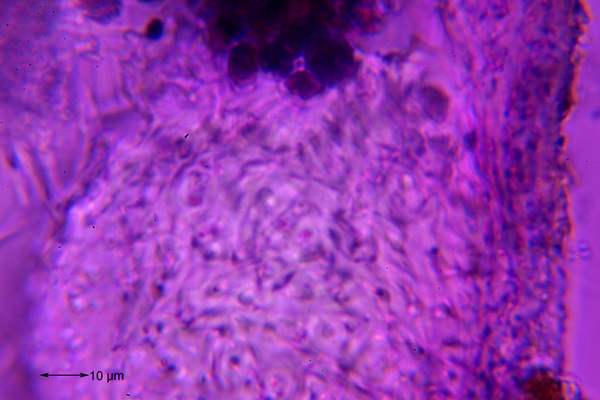
Felix Schumm - CC BY-SA 4.0
[10611], Portugal, Azoren, Sao Miguel: Agua de Pau, an Erica-Zweigen an der Atlantikküste bei der Hotelanlage Caloura, hohe Luftfeuchtigkeit und Salzeinfluß, 37°42.847'N, 25°30.906'W, 10-20 m. Leg. F. Schumm , 01.06.2003, det. F. Schumm 04.2006, conf. A. Aptroot 2007.
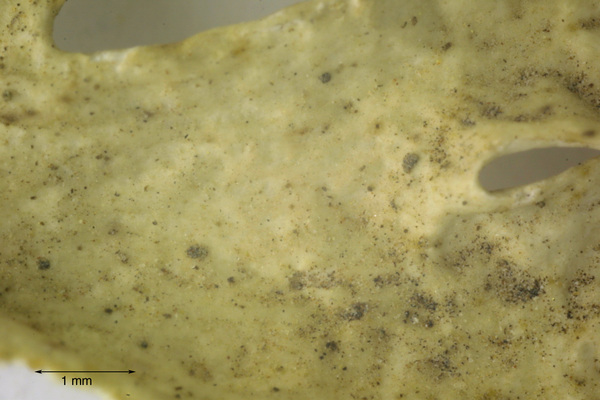
Felix Schumm - CC BY-SA 4.0
[10611], Portugal, Azoren, Sao Miguel: Agua de Pau, an Erica-Zweigen an der Atlantikküste bei der Hotelanlage Caloura, hohe Luftfeuchtigkeit und Salzeinfluß, 37°42.847'N, 25°30.906'W, 10-20 m. Leg. F. Schumm , 01.06.2003, det. F. Schumm 04.2006, conf. A. Aptroot 2007.
Growth form: Fruticose
Substrata: bark
Photobiont: green algae other than Trentepohlia
Reproductive strategy: mainly sexual
Most common in areas with a humid-warm climate (e.g. most of Tyrrenian Italy)
Commonnes-rarity: (info)
Alpine belt: absent
Subalpine belt: absent
Oromediterranean belt: absent
Montane belt: absent
Submediterranean belt: absent
Padanian area: absent
Humid submediterranean belt: absent
Humid mediterranean belt: extremely rare
Dry mediterranean belt: absent

Predictive model


Felix Schumm – CC BY-SA 4.0
Image from: F. Schumm (2008) - Flechten Madeiras, der Kanaren und Azoren. Beck, OHG - ISBN: 978-3-00-023700-3


P.L. Nimis; Owner: Department of Life Sciences, University of Trieste
Herbarium: TSB (20845)
2001/12/04

Felix Schumm - CC BY-SA 4.0
[10611], Portugal, Azoren, Sao Miguel: Agua de Pau, an Erica-Zweigen an der Atlantikküste bei der Hotelanlage Caloura, hohe Luftfeuchtigkeit und Salzeinfluß, 37°42.847'N, 25°30.906'W, 10-20 m. Leg. F. Schumm , 01.06.2003, det. F. Schumm 04.2006, conf. A. Aptroot 2007.

Felix Schumm - CC BY-SA 4.0
[10611], Portugal, Azoren, Sao Miguel: Agua de Pau, an Erica-Zweigen an der Atlantikküste bei der Hotelanlage Caloura, hohe Luftfeuchtigkeit und Salzeinfluß, 37°42.847'N, 25°30.906'W, 10-20 m. Leg. F. Schumm , 01.06.2003, det. F. Schumm 04.2006, conf. A. Aptroot 2007.

Felix Schumm - CC BY-SA 4.0
[10611], Portugal, Azoren, Sao Miguel: Agua de Pau, an Erica-Zweigen an der Atlantikküste bei der Hotelanlage Caloura, hohe Luftfeuchtigkeit und Salzeinfluß, 37°42.847'N, 25°30.906'W, 10-20 m. Leg. F. Schumm , 01.06.2003, det. F. Schumm 04.2006, conf. A. Aptroot 2007.

Felix Schumm - CC BY-SA 4.0
[10611], Portugal, Azoren, Sao Miguel: Agua de Pau, an Erica-Zweigen an der Atlantikküste bei der Hotelanlage Caloura, hohe Luftfeuchtigkeit und Salzeinfluß, 37°42.847'N, 25°30.906'W, 10-20 m. Leg. F. Schumm , 01.06.2003, det. F. Schumm 04.2006, conf. A. Aptroot 2007.

Felix Schumm - CC BY-SA 4.0
[10611], Portugal, Azoren, Sao Miguel: Agua de Pau, an Erica-Zweigen an der Atlantikküste bei der Hotelanlage Caloura, hohe Luftfeuchtigkeit und Salzeinfluß, 37°42.847'N, 25°30.906'W, 10-20 m. Leg. F. Schumm , 01.06.2003, det. F. Schumm 04.2006, conf. A. Aptroot 2007.

Felix Schumm - CC BY-SA 4.0
[10611], Portugal, Azoren, Sao Miguel: Agua de Pau, an Erica-Zweigen an der Atlantikküste bei der Hotelanlage Caloura, hohe Luftfeuchtigkeit und Salzeinfluß, 37°42.847'N, 25°30.906'W, 10-20 m. Leg. F. Schumm , 01.06.2003, det. F. Schumm 04.2006, conf. A. Aptroot 2007.

Felix Schumm - CC BY-SA 4.0
[10611], Portugal, Azoren, Sao Miguel: Agua de Pau, an Erica-Zweigen an der Atlantikküste bei der Hotelanlage Caloura, hohe Luftfeuchtigkeit und Salzeinfluß, 37°42.847'N, 25°30.906'W, 10-20 m. Leg. F. Schumm , 01.06.2003, det. F. Schumm 04.2006, conf. A. Aptroot 2007.

Felix Schumm - CC BY-SA 4.0
[10611], Portugal, Azoren, Sao Miguel: Agua de Pau, an Erica-Zweigen an der Atlantikküste bei der Hotelanlage Caloura, hohe Luftfeuchtigkeit und Salzeinfluß, 37°42.847'N, 25°30.906'W, 10-20 m. Leg. F. Schumm , 01.06.2003, det. F. Schumm 04.2006, conf. A. Aptroot 2007.

Felix Schumm - CC BY-SA 4.0
[10611], Portugal, Azoren, Sao Miguel: Agua de Pau, an Erica-Zweigen an der Atlantikküste bei der Hotelanlage Caloura, hohe Luftfeuchtigkeit und Salzeinfluß, 37°42.847'N, 25°30.906'W, 10-20 m. Leg. F. Schumm , 01.06.2003, det. F. Schumm 04.2006, conf. A. Aptroot 2007.

 INDEX FUNGORUM
INDEX FUNGORUM
 GBIF
GBIF
